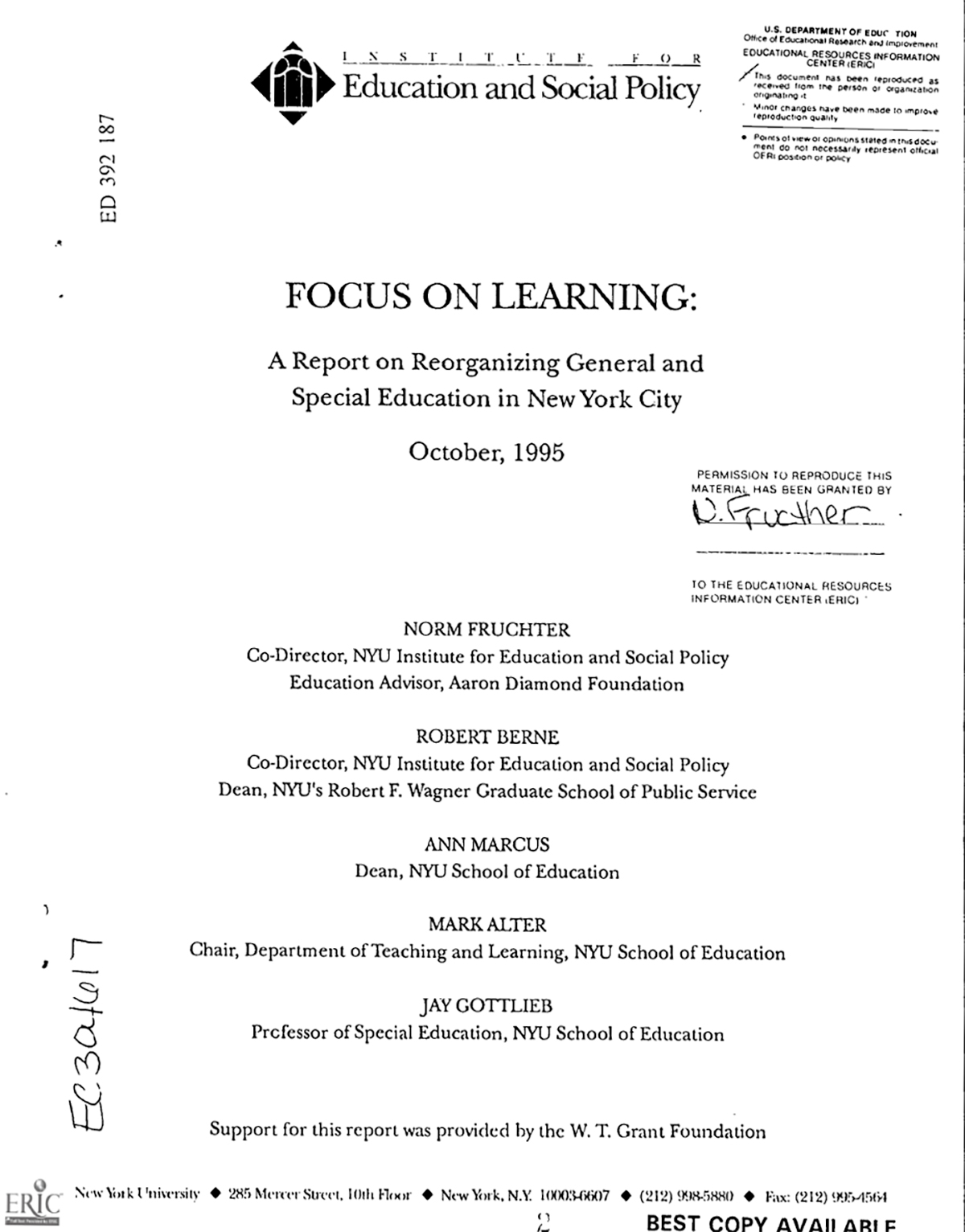Focus on Learning, excerpt

Date: October 1985
Caption: Researchers at NYU were invited by Board of Education Chancellor Ramon Cortines to study special education in the city. Their report discussed integrating special education into general education programs and districts.
Please note: This is work in progress. Please keep that in mind as you read. We are sharing this work in progress because these materials are relevant to discussions of school governance underway right now in New York. Please share your feedback at [email protected] and check back for updated versions soon.
From its earliest beginnings, special education in New York City was governed separately from the education of children without disabilities. The central Board of Education created programs, classes, and groups of schools designed for Disabled students or those that they labeled disabled. These schools did not fit into the same governance structure as other schools, but were led by officials in the board’s central office.
Parents of students with disabilities, and Disabled students, appear in the historical record of Black and Latinx educational protest that led up to community control. One of the members of the Harlem Nine had a son who was assigned to a “600” school for “maladjusted” young people.1 Milton Galamison, who helped organize the massive 1964 school boycott against school segregation, organized another boycott to protest racism, ableism, and inequality in the “600” schools. And Evelina López Antonetty fought against the mis-categorization of Spanish-speaking students as intellectually disabled. Yet despite these signs that the educational experiences of Disabled students or those labeled as disabled were very much present in educational activism, existing research makes it seem as if there was little discussion of special education and disability in the decentralization debates.1 Clearly this is an area that needs more investigation.
During decentralization, researchers at NYU were asked to study how New York organized the education of Disabled students and those labeled as disabled. Money was one big prompt for this study - a growing proportion of the city’s school budget was going to special educational services, and some thought that this proportion needed to be trimmed. Sometimes public discourse focused more on dollars than on what children needed.
By the mid-1990s, most special education classes and services were located in community school districts. But there was also a separate or segregated district for students with what were called more “severe” or “low-incidence” disabilities. This district was called District 75, but it was not a geographic district, and it did not have an elected school board. It was, despite the name, more an office of the central Board of Education than a decentralized community school district.
NYU researchers identified several problems with the education of students with disabilities in New York City. They suggested new approaches that would allow more Disabled students to stay in their community school districts. But that concerned some parents of Disabled children, who felt that having specialized and separate programs was the only way for their children to receive the education they deserved. These parents and some of their children voiced their opposition to the researchers’ suggestions.
-
See, for example, Diane Ravitch, The Great School Wars: A History of the New York Public Schools (Baltimore: Johns Hopkins University Press, 1974); Daniel Hiram Perlstein, Justice, Justice: School Politics and the Eclipse of Liberalism (New York: Peter Lang, 2004); Jerald E. Podair, The Strike that Changed New York: Blacks, Whites, and the Ocean Hill-Brownsville Crisis (New Haven: Yale University Press, 2002); Heather Lewis, New York City Public Schools from Brownsville to Bloomberg (New York: Teachers College Press, 2011). ↩︎ ↩︎
Categories: K-12 organizing
Tags: school facilities, curriculum, racist segregation, school administration, Disabled people, Deaf culture, learning disability, disability labels
This item is part of "Decentralization: Community School Districts For Some" in "Who Governs Schools?"
Item Details
Date: October 1985
Creator: Norm Fruchter, Robert Berne, Ann Marcus, Mark Alter, and Jay Gottleib
Source: Education Resources Information Center
Copyright: Under copyright
How to cite: “Focus on Learning, excerpt,” Norm Fruchter, Robert Berne, Ann Marcus, Mark Alter, and Jay Gottleib, in New York City Civil Rights History Project, Accessed: [Month Day, Year], https://nyccivilrightshistory.org/gallery/focus-on-learning.
Questions to Consider
- The researchers identified several criticisms of special education. Have these concerns been addressed, or do they continue today?
- Although most students in special education attended schools in a community school district, others were in a separate district only for Disabled students. Did Disabled students experience “decentralized” school governance? How did this affect their parents’ ability to advocate for their children?
- The researchers suggested that Disabled students attend classrooms and schools with non-disabled students. Several Disabled students and their parents raised concerns about this. What were the students’ and parents’ concerns?
References
How to Print this Page
- Press Ctrl + P or Cmd + P to open the print dialogue window.
- Under settings, choose "display headers and footers" if you want to print page numbers and the web address.
- Embedded PDF files will not print as part of the page. For best printing results, download the PDF and print from Adobe Reader or Preview.
